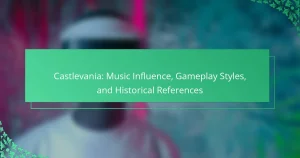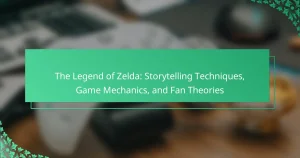Final Fantasy VII is a cornerstone of the RPG genre, known for its intricate plot and character development. This article analyzes key plot elements, explores character arcs, and examines the game’s lasting impact on RPGs. It highlights themes of identity, environmentalism, and the innovative gameplay mechanics that set new standards in storytelling.
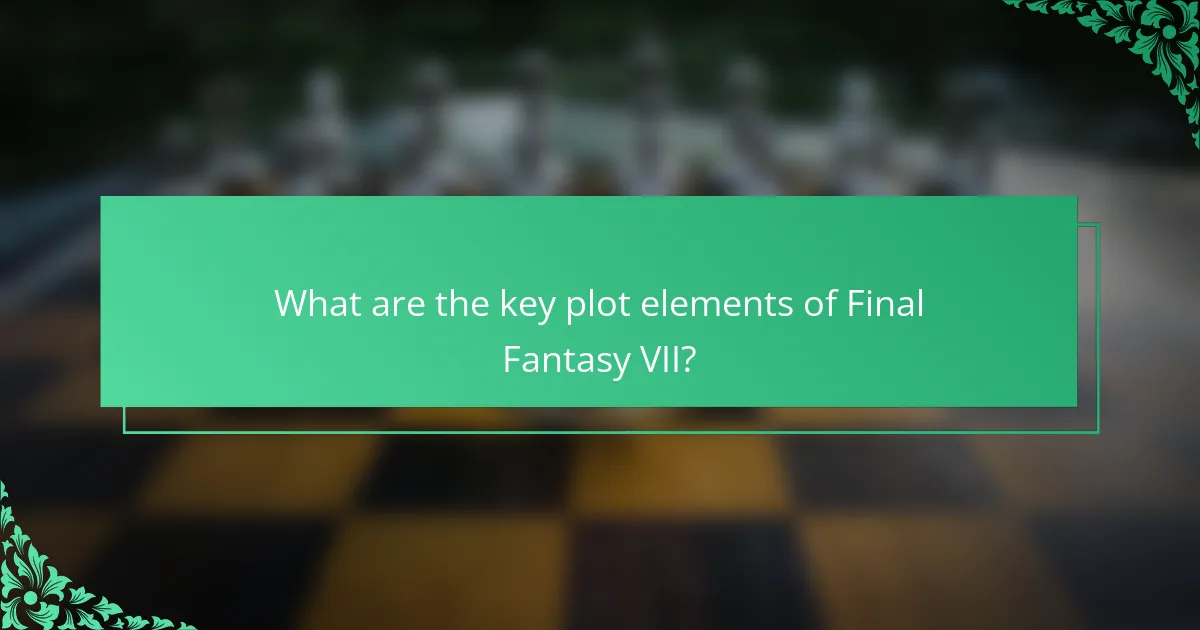
What are the key plot elements of Final Fantasy VII?
Final Fantasy VII features key plot elements such as the struggle against the Shinra Electric Power Company, the quest to stop the antagonist Sephiroth, and the exploration of themes like identity and environmentalism. The narrative follows Cloud Strife, a mercenary with a mysterious past, as he joins a group called AVALANCHE to combat Shinra’s exploitation of the planet. Character development is significant, particularly with Cloud’s evolving understanding of himself and his relationships with other characters like Tifa Lockhart and Aerith Gainsborough. The game’s impact on RPGs is profound, influencing storytelling, character depth, and cinematic presentation in the genre.
How does the narrative structure enhance player engagement?
The narrative structure of Final Fantasy VII significantly enhances player engagement through its intricate storytelling. By intertwining character backstories, emotional arcs, and thematic depth, the game creates a compelling world that players invest in. This structure allows for a unique attribute of character development, where each character’s journey resonates with players, fostering emotional connections. Additionally, the use of plot twists and cliffhangers keeps players eager to uncover the next chapter. As a result, the narrative not only propels the gameplay but also elevates the overall RPG experience, setting a benchmark for future titles.
What themes are explored throughout the story?
Final Fantasy VII explores themes of identity, loss, environmentalism, and the struggle against fate. The narrative delves into the characters’ personal journeys, particularly Cloud’s quest for self-discovery and redemption. Environmental destruction is highlighted through Shinra’s exploitation of the planet, prompting reflections on sustainability. Additionally, the impact of trauma and the importance of memory are recurrent motifs that shape character development and relationships. These themes contribute significantly to the game’s lasting impact on the RPG genre.
Which pivotal moments define the storyline?
Key moments defining the storyline of Final Fantasy VII include Cloud’s identity crisis, Aerith’s tragic death, the confrontation with Sephiroth, and the revelation of the planet’s fate. These pivotal events shape character arcs and influence the game’s themes of loss, identity, and environmentalism. The impact of these moments resonates deeply within the RPG genre, setting a precedent for narrative complexity.
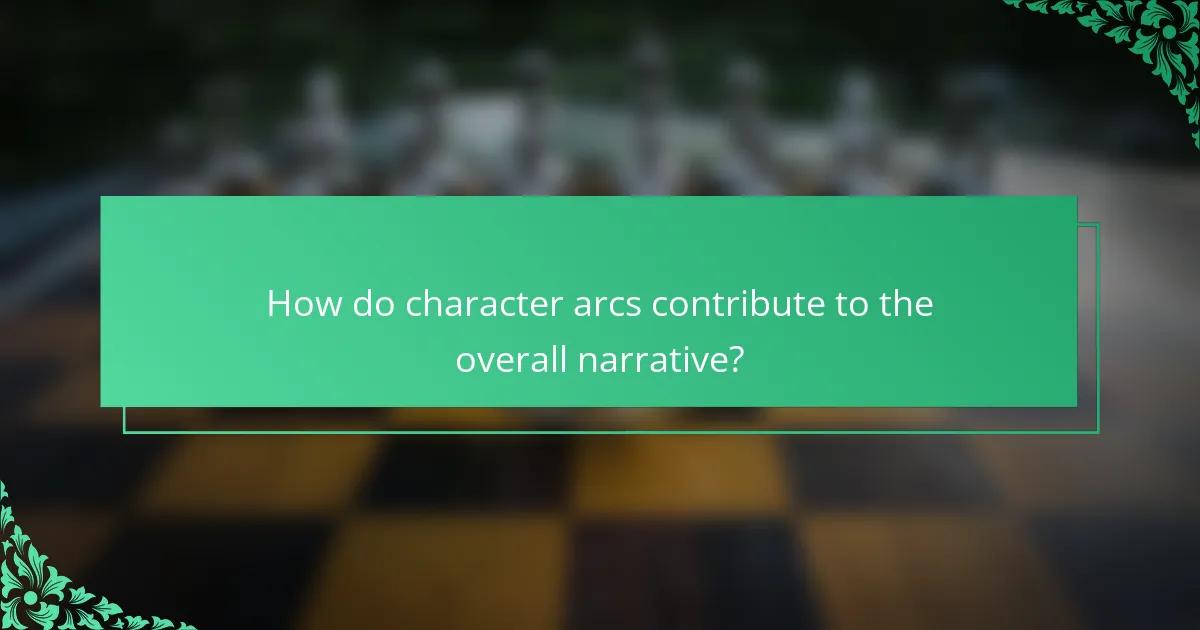
How do character arcs contribute to the overall narrative?
Character arcs significantly enhance the narrative by providing depth and emotional resonance. In “Final Fantasy VII,” characters like Cloud Strife undergo profound transformations that reflect their struggles and growth. These arcs create a dynamic interplay between personal and overarching themes, enriching the plot’s complexity. For instance, Cloud’s journey from a confused mercenary to a self-aware hero illustrates the impact of identity and memory on personal development. This character evolution not only drives the story forward but also engages players, making their experiences more immersive and relatable.
What are the primary motivations of main characters?
The primary motivations of main characters in Final Fantasy VII include personal growth, revenge, and the desire to protect loved ones. Cloud Strife seeks identity and redemption, driven by his past and relationships. Tifa Lockhart is motivated by loyalty and love, while Aerith Gainsborough embodies hope and sacrifice. Sephiroth’s motivations stem from power and vengeance against humanity. Each character’s journey reflects deeper themes of existential struggle and emotional connection, enhancing the game’s narrative complexity.
How do relationships evolve among characters?
Relationships among characters in Final Fantasy VII evolve through shared experiences, conflicts, and emotional growth. Key moments, such as battles and personal challenges, deepen their connections. For instance, Cloud’s journey with Aerith and Tifa illustrates how trust and vulnerability shape their bonds. The impact of loss, particularly during pivotal story arcs, drives character development and influences their interactions. This dynamic progression reflects the game’s broader themes of identity and connection, making character relationships central to its narrative impact on RPGs.
Which characters exhibit significant growth throughout the game?
Cloud Strife, Tifa Lockhart, and Barret Wallace exhibit significant growth throughout Final Fantasy VII. Cloud evolves from a confused mercenary to a self-aware hero. Tifa transitions from a childhood friend to a strong fighter embracing her past. Barret transforms from a vengeful leader to a compassionate figure advocating for the planet’s future. Each character’s journey highlights themes of identity, responsibility, and redemption, enhancing the game’s emotional depth.
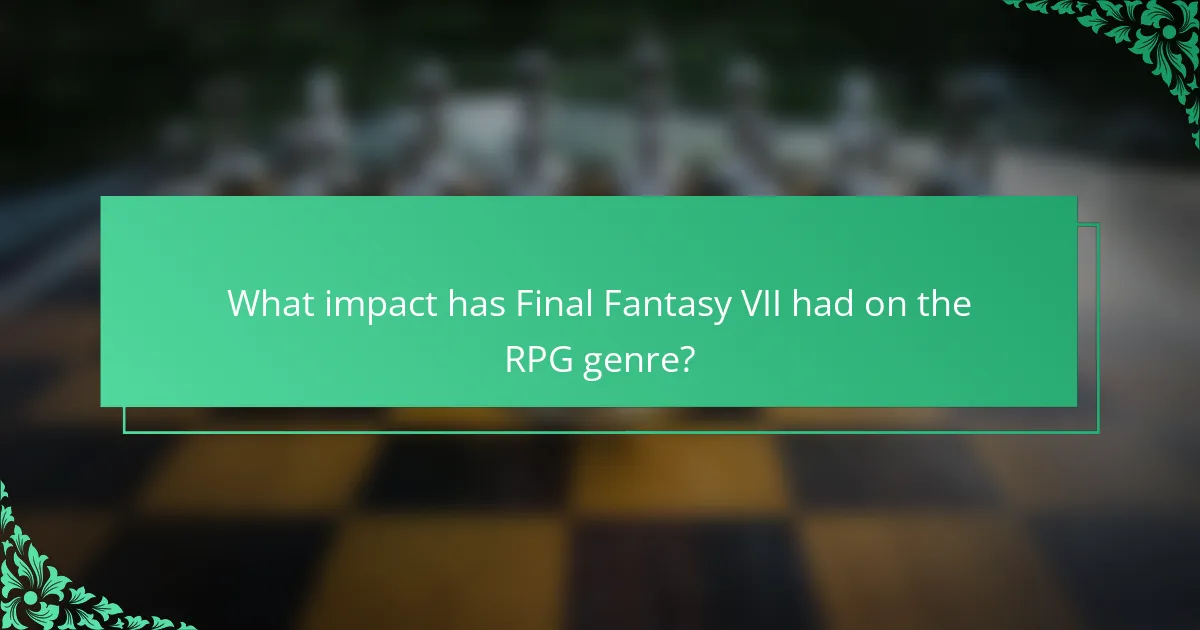
What impact has Final Fantasy VII had on the RPG genre?
Final Fantasy VII significantly shaped the RPG genre by introducing cinematic storytelling and complex character arcs. Its innovative gameplay mechanics, such as the Materia system, allowed for deep customization. The game’s emotional depth and themes of identity and loss resonated widely, influencing future titles. As a result, it set new standards for narrative and character development in RPGs.
How did it influence game design and storytelling in subsequent RPGs?
Final Fantasy VII significantly influenced game design and storytelling in subsequent RPGs by introducing complex narratives and character arcs. It emphasized emotional depth, notably through character development and relationships, setting a new standard for storytelling. The game’s use of cinematic cutscenes enhanced immersion, inspiring future titles to adopt similar techniques. Additionally, its exploration of themes like identity and loss resonated with players, encouraging developers to craft more nuanced stories. As a result, RPGs began to prioritize character-driven plots, leading to richer gameplay experiences.
What are the lasting cultural effects of the game?
Final Fantasy VII has significantly influenced gaming culture, shaping narratives and character development in RPGs. Its complex storyline and character arcs set new standards for emotional engagement in games. The game introduced themes of environmentalism and identity, resonating with players and inspiring discussions about societal issues. Additionally, its innovative gameplay mechanics and cinematic presentation redefined expectations for future RPGs. This lasting impact is evident in numerous titles that followed, which adopted similar narrative depth and character complexity.
Which innovations were introduced in Final Fantasy VII?
Final Fantasy VII introduced several innovations that transformed RPGs. Notable advancements include a 3D graphical environment, a real-time battle system, and the Materia system for character customization. The game also featured a complex narrative structure and character development, elevating storytelling in video games. Additionally, the use of cinematic cutscenes enhanced player immersion and engagement.
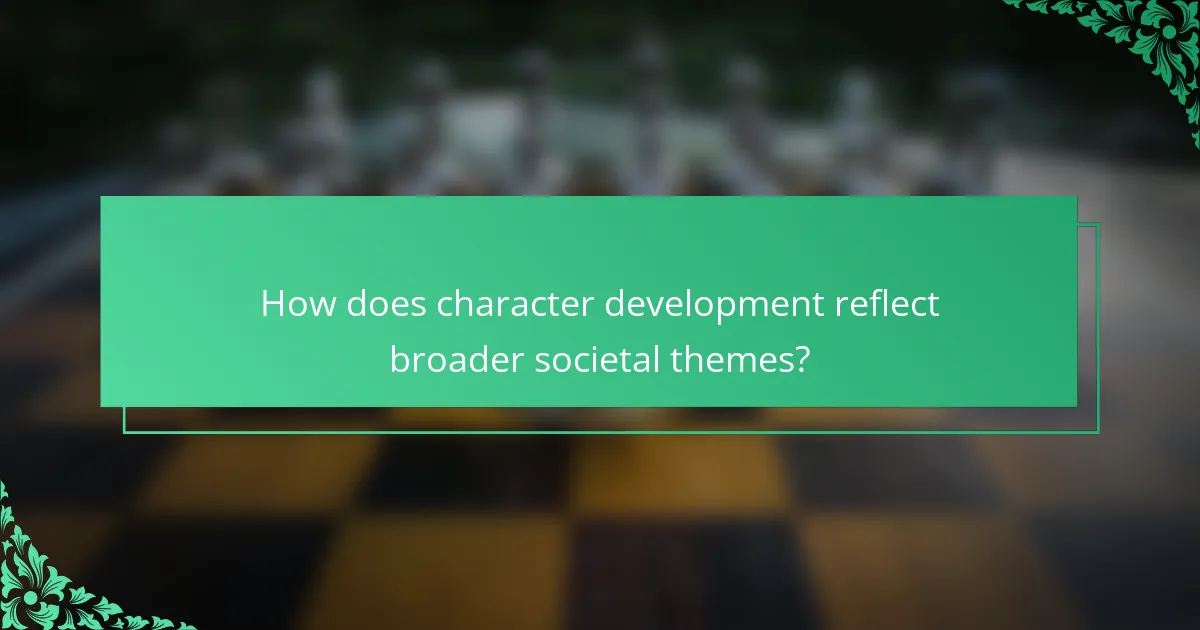
How does character development reflect broader societal themes?
Character development in Final Fantasy VII mirrors broader societal themes such as environmentalism, identity, and trauma. The characters’ struggles reflect real-world issues, making the narrative resonate deeply with players. For instance, Cloud Strife’s journey represents the search for self amidst societal expectations, while Aerith Gainsborough symbolizes the connection to nature and the consequences of industrialization. These character arcs encourage players to engage with complex themes, fostering empathy and reflection on their own lives. Ultimately, the game’s character development serves as a vehicle for exploring significant societal concerns, enhancing its impact on the RPG genre.
What psychological elements are portrayed through character experiences?
Final Fantasy VII portrays psychological elements through character experiences such as trauma, identity, and redemption. Characters like Cloud Strife grapple with their past, revealing how memories shape their present. Tifa Lockhart exemplifies the struggle between support and personal growth, while Sephiroth embodies the conflict between power and humanity. These dynamics illustrate the impact of psychological struggles on character development, influencing player engagement and emotional investment. The game effectively uses these elements to deepen the narrative, contributing to its lasting impact on RPGs.
How do character backgrounds shape their decisions?
Character backgrounds significantly influence their decisions in Final Fantasy VII. Each character’s history shapes their motivations, relationships, and responses to challenges. For example, Cloud Strife’s past as a soldier and his struggle with identity drive his quest for self-discovery. Tifa Lockhart’s deep connection to her hometown and her protective nature toward Cloud illustrate how personal experiences dictate actions. Additionally, Sephiroth’s tragic backstory transforms him into a formidable antagonist, showcasing how backgrounds can lead to divergent paths. Ultimately, these character backgrounds create a rich narrative tapestry that enhances player engagement and emotional investment.
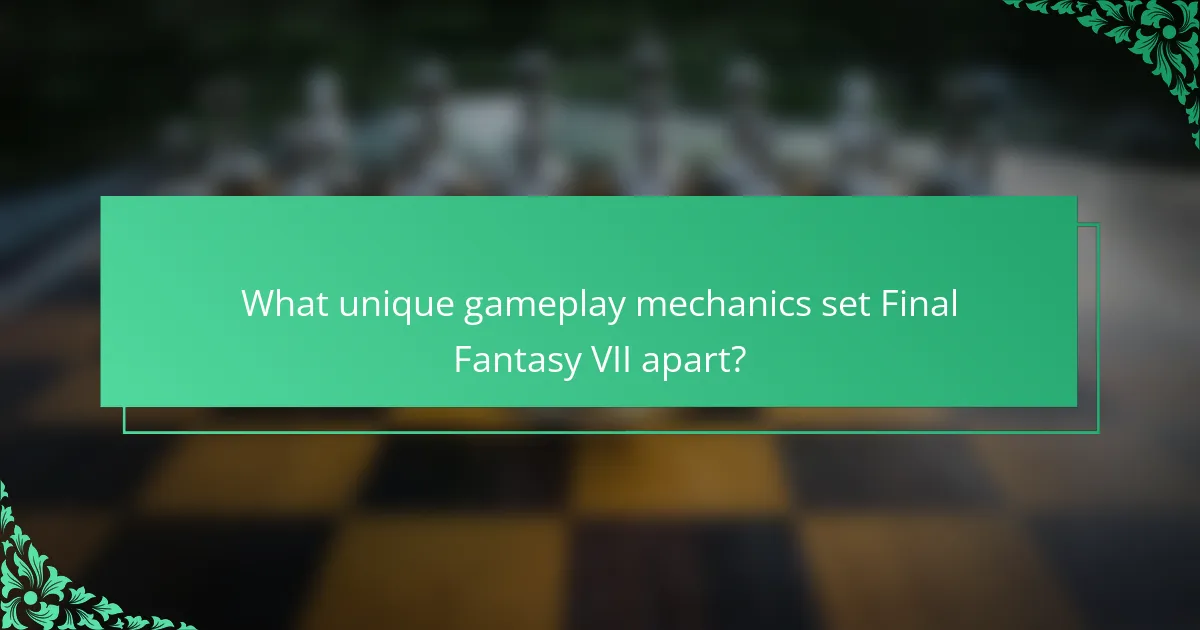
What unique gameplay mechanics set Final Fantasy VII apart?
Final Fantasy VII features unique gameplay mechanics that distinguish it from other RPGs. Its Active Time Battle system allows real-time decision-making during combat, enhancing strategy. The Materia system offers deep customization by enabling character skill combinations and magical abilities. Additionally, the game’s nonlinear narrative structure encourages exploration and player choice, impacting story outcomes. These elements collectively create a rich and immersive gaming experience that has influenced the RPG genre significantly.
How do materia and summon systems enhance strategy?
Materia and summon systems enhance strategy by providing diverse tactical options and resource management. Materia allows players to customize character abilities, enabling unique combinations. Summons introduce powerful allies that can change battle dynamics, offering strategic advantages. This flexibility encourages players to adapt their approach based on enemy types and challenges. The systems deepen engagement, allowing for experimentation and personalized playstyles. Overall, they contribute to the game’s complexity and depth, reinforcing Final Fantasy VII’s impact on RPG design.
What role do mini-games play in player experience?
Mini-games enhance player experience in Final Fantasy VII by providing variety and engagement. They offer opportunities for character development and world exploration. For instance, the Chocobo racing mini-game allows players to interact with the game’s ecosystem, deepening immersion. Additionally, mini-games can reward players with unique items, influencing gameplay strategy. This integration of mini-games contributes to the overall narrative, making the RPG experience richer and more dynamic.
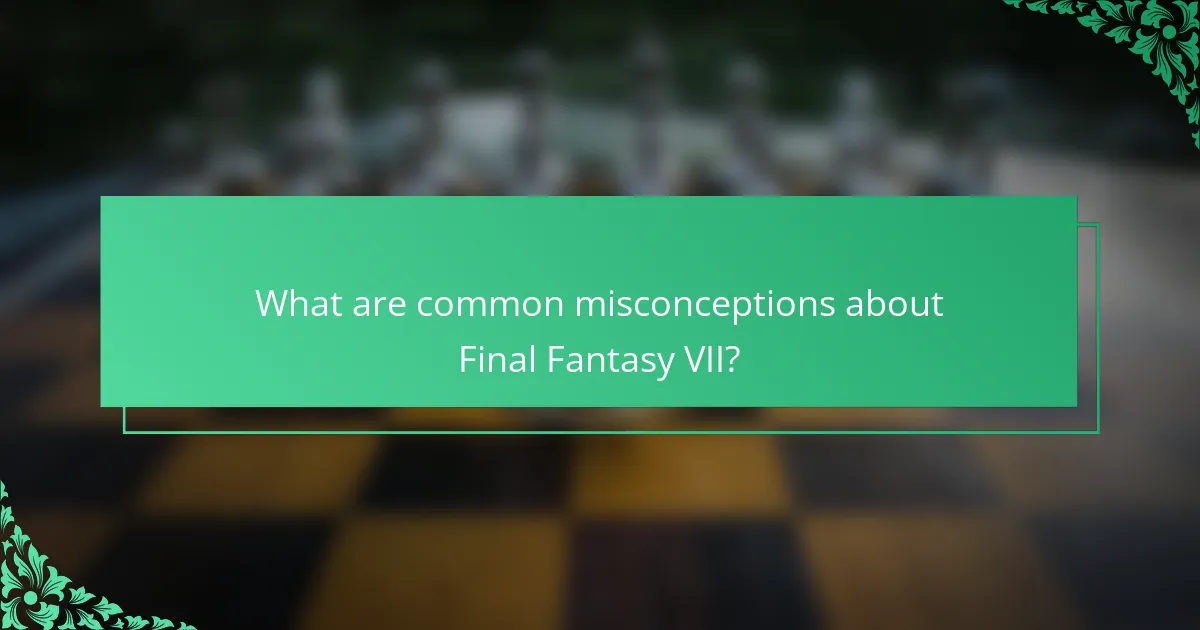
What are common misconceptions about Final Fantasy VII?
Many misconceptions about Final Fantasy VII stem from its complex narrative and character arcs. One common belief is that Cloud Strife is the main villain, but he is actually the protagonist grappling with his identity. Another misconception is that Aerith Gainsborough’s death is solely a shock tactic; it serves to deepen the emotional stakes and character development. Additionally, some players think the game promotes environmentalism purely for its plot, while it subtly critiques corporate greed and personal responsibility. Lastly, many assume the graphics are outdated, but they were groundbreaking for their time and still hold nostalgic value.
How do fan theories shape the understanding of the plot?
Fan theories significantly influence the understanding of Final Fantasy VII’s plot by offering alternative interpretations and deeper insights. These theories encourage players to explore character motivations and plot nuances, enhancing engagement with the narrative. For instance, theories surrounding Aerith’s fate reveal themes of sacrifice and destiny, prompting discussions about the impact of her character on the game’s emotional depth. Additionally, fan theories often highlight unique attributes, such as the significance of the Lifestream, which enriches the lore and invites speculation about the game’s world-building. Overall, these theories foster a community dialogue that shapes collective perceptions of the game’s storyline and character development.
What are the most debated aspects of character motivations?
The most debated aspects of character motivations in Final Fantasy VII include the complexity of Cloud’s identity, Sephiroth’s tragic backstory, and Tifa’s emotional struggles. Cloud’s conflicting memories and motivations raise questions about his true self. Sephiroth’s transformation from hero to villain invites discussions on the nature of evil. Tifa’s internal conflict about loyalty and love adds depth to her character, prompting debates on emotional resilience. These motivations significantly impact player engagement and narrative interpretation.
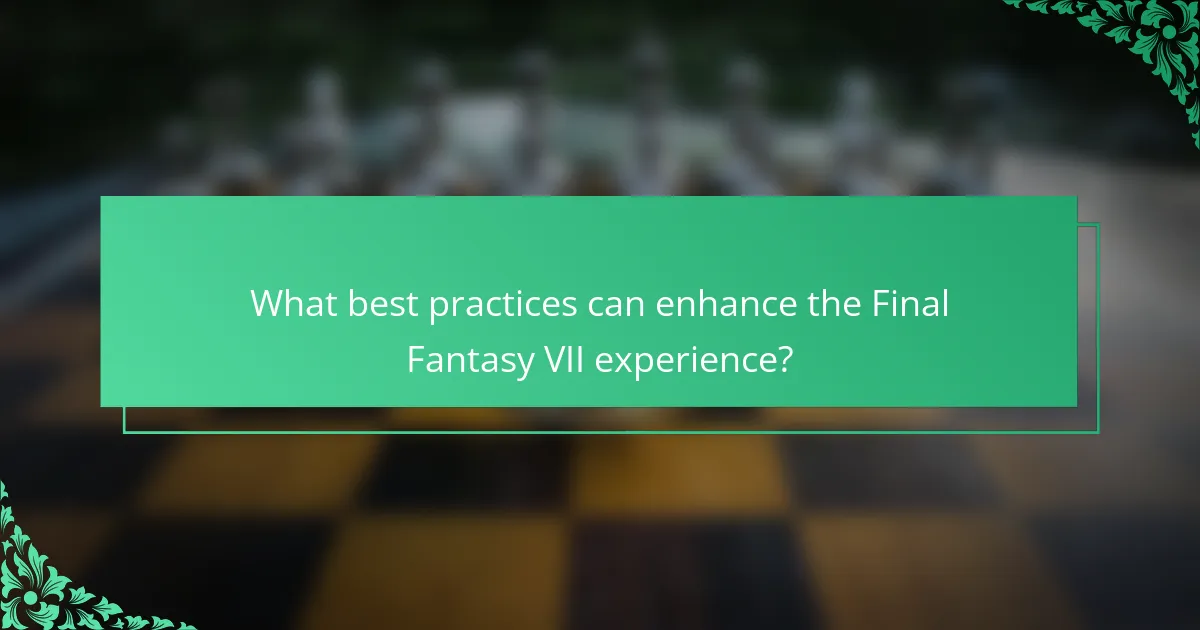
What best practices can enhance the Final Fantasy VII experience?
To enhance the Final Fantasy VII experience, immerse yourself in its rich narrative and character arcs. Engage with fan theories and discussions to deepen understanding of plot intricacies. Explore the game’s diverse mechanics, such as materia and combat systems, to maximize gameplay. Additionally, consider playing the remastered versions for improved graphics and audio, which enrich the overall experience.
How can players effectively engage with the story and characters?
Players can engage with the story and characters of Final Fantasy VII by immersing themselves in the narrative and making choices that reflect their values. Understanding character backstories enhances emotional connections. Exploring the game’s world through side quests reveals deeper lore and character motivations. Engaging with other players through discussions can provide new insights and perspectives on the story.
What tips can improve gameplay and strategy?
To improve gameplay and strategy in Final Fantasy VII, focus on character development, resource management, and strategic battle tactics.
Utilize Materia effectively by combining spells for powerful effects. Prioritize leveling up characters with balanced stats to enhance their combat roles. Explore the world thoroughly to find hidden items and side quests, which can provide valuable resources.
Engage in battles with a clear strategy, such as staggering enemies and exploiting elemental weaknesses. Regularly save progress to avoid losing hard-earned achievements.
Consider forming a diverse party to cover various combat styles, ensuring adaptability in different scenarios.
